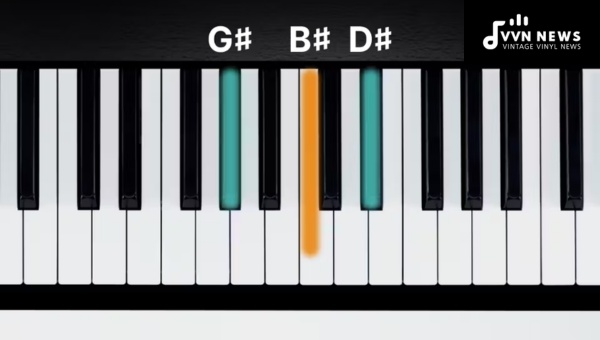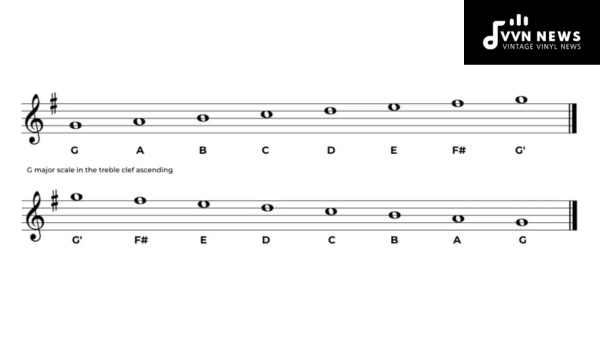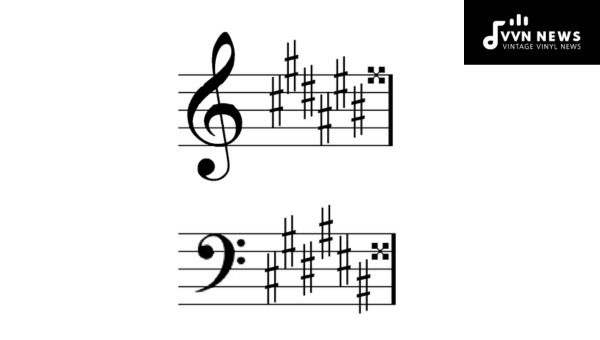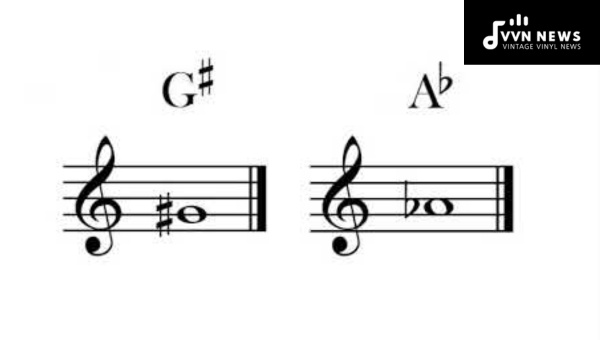As a melody weaves its way through a piece of music, certain notes have the power to catch our ears and linger in our memory.
The G sharp music note, for instance, often stands out as a distinct pitch in compositions that can both enchant and perplex listeners and musicians alike.
Its unique position on the keyboard and in the scales makes it an intriguing topic for those of us fascinated by the intricacies of musical theory and its practical applications.
Whether you’re a budding musician eager to master your scales or simply someone who appreciates the nuances of sound, getting to know G sharp is an essential step on your musical journey.
In this article, I’ll guide you through everything you need to know about this compelling note and how it fits into the grand tapestry of music’s rich landscape.
Locating G Sharp on the Staff
When you’re scanning sheet music, finding G sharp may seem daunting at first. On the treble clef, G sharp resides on the top line, with the addition of a sharp (♯) sign, modifying the G note.
For those reading bass clef, look just above the top line; that’s where G sharp makes its home—also signaled by a sharp.
Remember, it’s the same key as A flat (A♭) but used differently depending on the key signature or melodic context.
Spotting this note quickly becomes second nature as you familiarize yourself with musical notation and sharpen your sight-reading skills.
The G Sharp Note on Piano and Keyboard

On your piano or keyboard, the G Sharp (G#) note is the black key immediately to the right of the white G key.
It’s easily identifiable because it’s grouped with a set of three black keys. In music notation, you’ll see it marked with a “#” symbol (sharp) next to the G on sheet music.
When your fingers press this ebony key, they’re engaging with a pitch that is one semitone higher than G natural.
Playing a G# gives your composition a raised tone which can evoke different emotions or resolutions within your piece.
Interestingly, this same black key is also referred to as A Flat (Ab), depending on the musical context but that’s another story altogether.
As you explore scales and chords, you’ll notice how integral this versatile note is to creating harmonious and dynamic music.
Also Read: B Major: The Scale And Chords [Guide To This Bold & Beautiful Key]
Variations of G Sharp with Accidentals
When exploring the nuances of the G sharp note, it’s crucial to understand the role of accidentals in music notation and performance.
G sharp itself is considered an accidental—note that is raised a half step from its natural form, in this case, G natural.
Enharmonic Equivalents
The enharmonic equivalent of G sharp is A flat. These two notes sound identical but are written differently depending on the key signature or harmonic context within a piece.
While G sharp implies a sharpening from G, A flat suggests a lowering from A.
Double Sharps and Flats
In some compositions, you may encounter a G double sharp, notated as Gx, which means you raise the note by a whole step from its natural, making it equivalent to an A natural in pitch.
Alternatively, an A double flat (Abb) would be reduced by a whole step from its natural state, also sounding as a G natural.
Accidents alter our approach to interpreting and playing music. They provide composers with tools for conveying intricate harmonies and for guiding instrumentalists through complex melodic lines.
G Sharp in Various Musical Clefs

When you delve into the world of music notation, understanding the placement of notes like G sharp across various clefs is crucial.
Each clef assigns a different position to notes on the staff, which can initially be confusing.
Let’s explore where G sharp lands within each of these musical signposts.
Treble Clef
In the treble clef, commonly used for higher-pitched instruments such as the violin or flute, G sharp occurs on the first line of the staff when marked with a sharp accidental.
To envision this, imagine placing a note on the E line and raising it to G sharp using a sharp symbol.
Also Read: How Much Should You Charge For Music Lessons? [Fair Rates Guide]
Bass Clef
For lower-pitched instruments like the bass guitar or cello, we turn to the bass clef.
Here, G sharp sits above the top line of the staff, hovering as if it were an extension beyond the realm of regular notes—a ledger line would be employed for its notation.
Alto Clef
Primarily used for viola and occasionally by other middle-voiced instruments, in alto clef, G sharp finds its place right on top of the middle line.
This positioning makes it relatively easy to spot due to its centrality on the staff.
Tenor Clef
The tenor clef shares some characteristics with alto but adjusts for slightly higher ranges—as with certain trombone or bassoon passages.
In this setting, G sharp appears on the second line from below with an upward tilt from F’s natural place.
Mezzo-Soprano Clef
Although less common today, mezzo-soprano singers may still encounter their unique clef in older scores.
Within this context, G sharp sits comfortably just above middle C—specifically on that first ledger line above.
Soprano Clef
Tracing back mainly to vocal music’s history books is where you’ll find soprano clef markings.
With respect to G sharp in a soprano landscape, it ascends boldly two ledger lines up from middle C—a true high-flier.
Baritone Clef
Lastly comes baritone clef—another rare sight in modern ensembles but worth knowing nonetheless.
For those baritone vocalists or instrumentalists tackling this notation style, G sharp will appear just below G when donning a keen accidental mark; that’s right there at C’s third space from below position but modified upwards in pitch.
Each time we encounter clefs, whether standard ones like treble and bass or less frequent travelers like mezzo-soprano and baritone, we must adjust our understanding of where familiar notes like G sharp find their homes.
Also Read: E Flat Minor Pentatonic Scale [Master This Key With Our Guide]
Scales That Begin with G Sharp
Exploring scales that commence on G Sharp can be a dazzling expedition into the world of music theory.
Let’s delve into two primary kinds of scales that originate from this compelling note.
Major Scale
Firstly, the G sharp major scale is a rarity due to its enharmonic equivalent, A flat major, which is often preferred for its simpler notation.
However, you can construct it by following the whole-whole-half-whole-whole-whole-half step formula: G♯-A♯-B♯-C♯-D♯-E♯-Fx-G♯ (Fx represents F double sharp).
It’s bold and should be understood for comprehensive musical knowledge.
Minor Scales
When considering minor scales at this pitch level, there are three varieties:
- Natural Minor: The sequence starts from G sharp and progresses in the pattern: whole-half-whole-whole-half-whole-whole.
- Harmonic Minor: This scale introduces a raised seventh degree, creating a unique sound known for its Middle Eastern vibes.
- Melodic Minor: Exhibiting a dual personality, the ascending melodic minor differs from its descending counterpart by featuring raised sixth and seventh degrees ascending and reverting to a natural minor while descending.
Each scale offers its own flavor and challenges to both players and composers.
Mastery of these scales not only boosts technical proficiency but also enriches your improvisational toolkit.
Also Read: 22 Best MIDI Controller Buying Guide [Choose The Right Gear]
Modes Initiated by the G Sharp Note

The world of musical modes opens up an expanse of creative possibilities, particularly for those who dive into the depths of scales initiated by specific notes like G Sharp.
In the realm of modes, each tone can be a starting point for a uniquely flavored scale that sets the mood for entire musical pieces.
Ionian Mode (Major Scale)
Starting from G sharp in Ionian mode conjures up the G# Major Scale a scale seldom used due to its large number of sharps and double sharps.
This use might be more theoretical than practical, given its enharmonic equivalent of A flat major which is far more common in compositions.
Dorian Mode
The Dorian mode beginning on G sharp is both sad and subtly uplifting.
Its natural minor plus a major sixth gives it a duality – somewhat somber with an unexpected brightness.
Phrygian Mode
If you’re drawn to the exotic or ethereal, then starting the Phrygian mode on G sharp will satisfy that craving.
It has an air of mystery partly due to its semitones from the first to second notes.
Lydian Mode
Initiating Lydian on G sharp offers a dreamy, almost effervescent quality often associated with fantasy or futuristic themes thanks to its raised fourth degree.
Mixolydian Mode
For a bluesy touch or something that resonates with folk music’s earthiness, starting Mixolydian on the G sharp note provides just enough deviation from major to intrigue listeners’ ears.
Also Read: 24 Best Metal Guitars Guide To Amps, Strings, & Pickups
Aeolian Mode (Natural Minor Scale)
The Aeolian mode initiated on this note renders the G# minor scale, imposing a contemplative and introspective mood often used in genres ranging from classical to rock music.
Locrian Mode
Locrian might be considered one of music’s rarities because it begins and ends with diminished intervals.
Beginning this on G sharp offers something distinctive—a scale where the tension lives within every step and resolution feels perpetually out-of-reach.
Each mode carries its unique combination of steps and intervals, transforming how we perceive and employ the initial note—G sharp in this case—within different musical contexts.
G Sharp Note Frequency Details
When we delve into the realm of music theory, the G sharp note emerges as more than just a spot on the musical canvas.
It inhabits a specific frequency, vibrating at 830.61 Hz in standard tuning. This detail is pivotal for audio engineers and producers who often work with equalization and tuning software, ensuring instruments are harmonically aligned.
For musicians, recognizing that G sharp is acoustically equivalent to A flat (Ab) can be enlightening; these are enharmonic notes—they sound identical despite their different names.
FAQ About the G Sharp Music Note
What instruments can play a G sharp note?
All musical instruments that have a chromatic range, including pianos, guitars, violins, and woodwinds, can play a G sharp note.
Is G sharp the same as A flat?
Yes, in most cases, G sharp (G#) is enharmonically equivalent to A flat (Ab), meaning they are two different names for the same pitch on many instruments.
How do I find G sharp on the guitar?
On the guitar, you can find G# by playing the fourth fret on the bottom E string or by pressing down the first fret on the G string.
Where does G# sit in terms of octave frequency?
The G#4 note typically has a frequency of around 415.30 Hz, sitting just above middle C in the fourth octave on a standard piano.
Does G# appear often in popular music?
Absolutely! G# is frequently used in various keys and chords within popular music, contributing to interesting harmonies and melodic lines.
Conclusion
G sharp is more than just a semitone above G; it’s a fascinating element in the fabric of music.
Whether you’re finding its place on the piano, understanding its role in scales, or recognizing its pitch in your favorite songs, this note undoubtedly contributes to the dynamic world of sound that resonates with us all.
Embrace the harmonic possibilities G sharp offers and let your musical expression soar.








